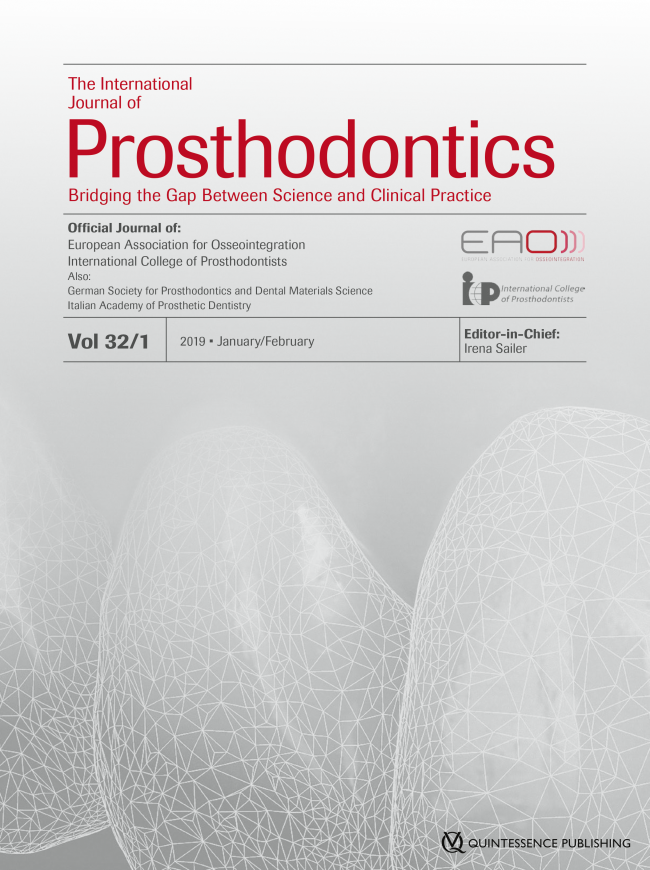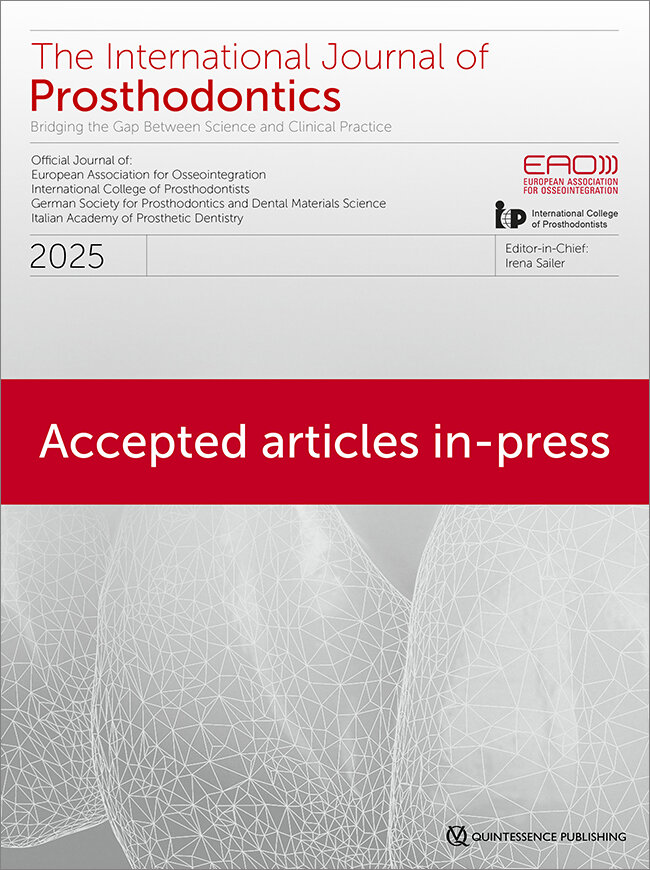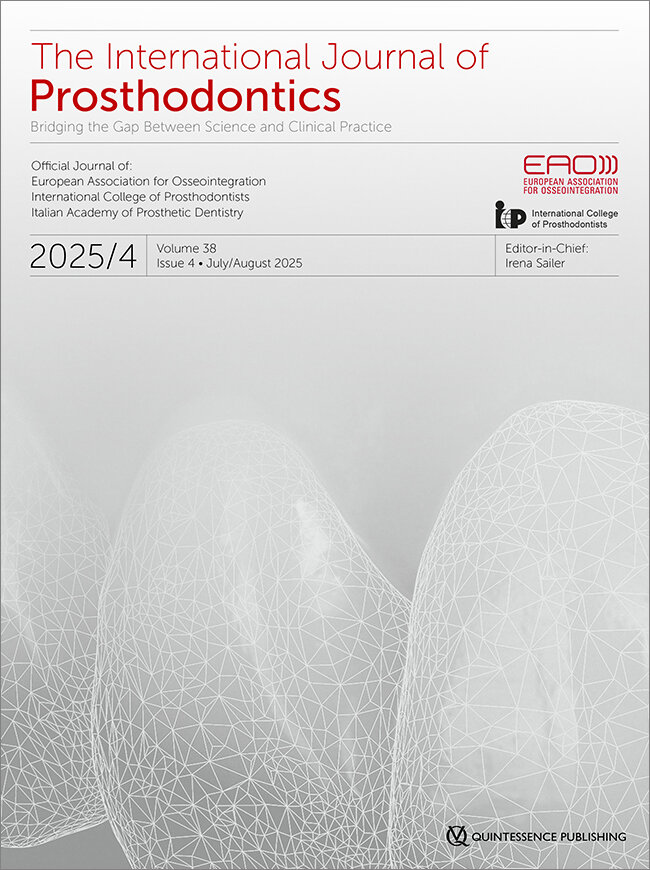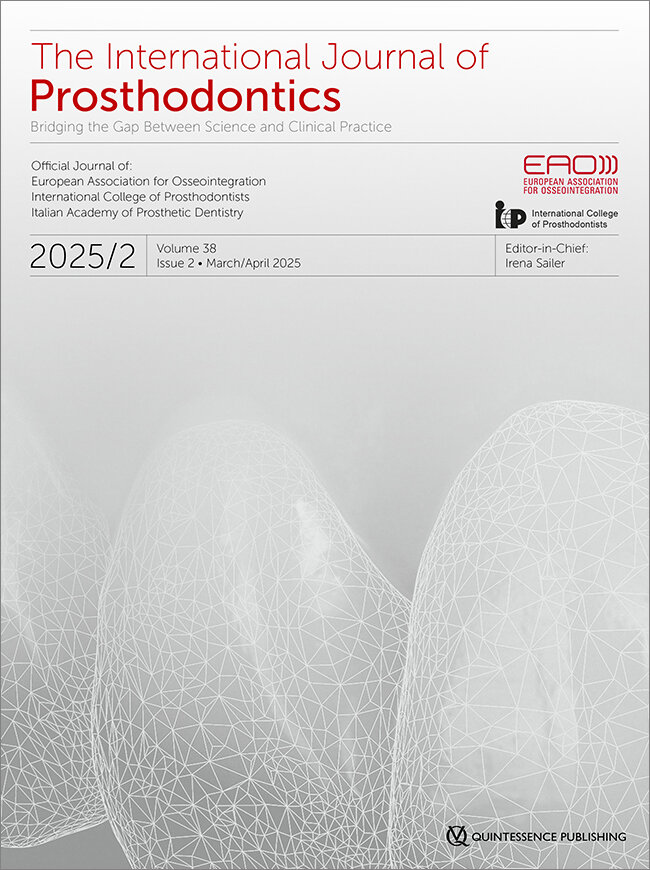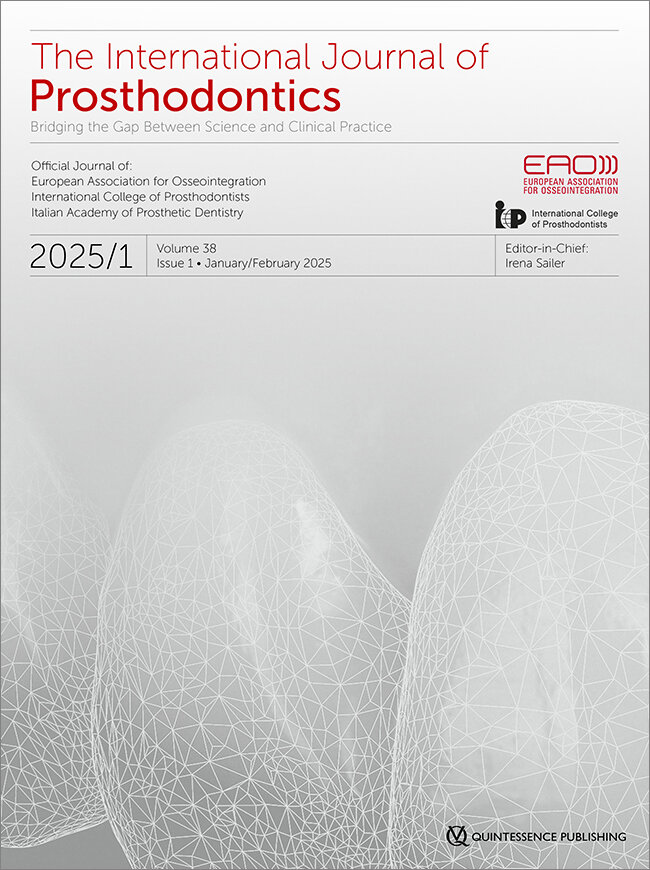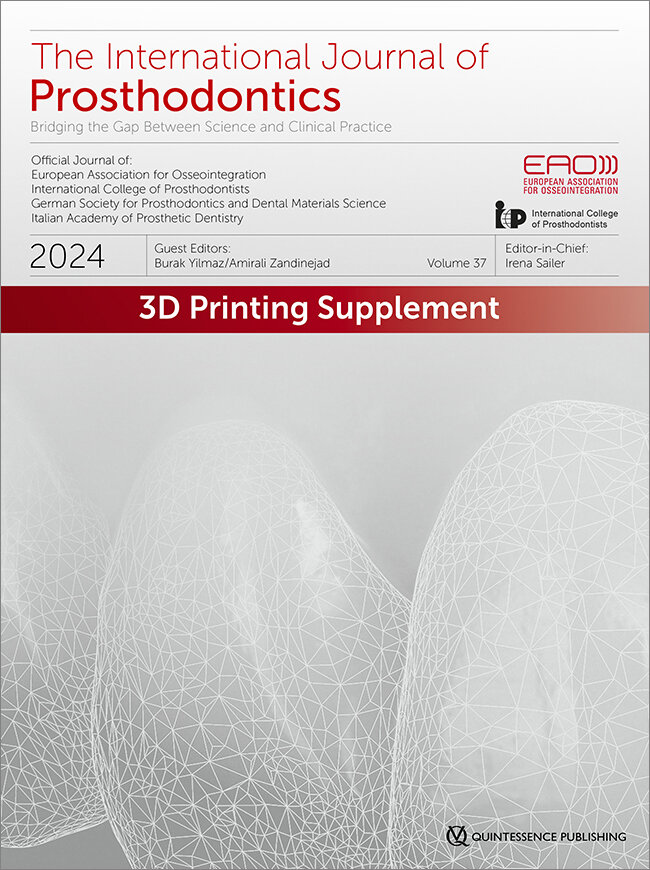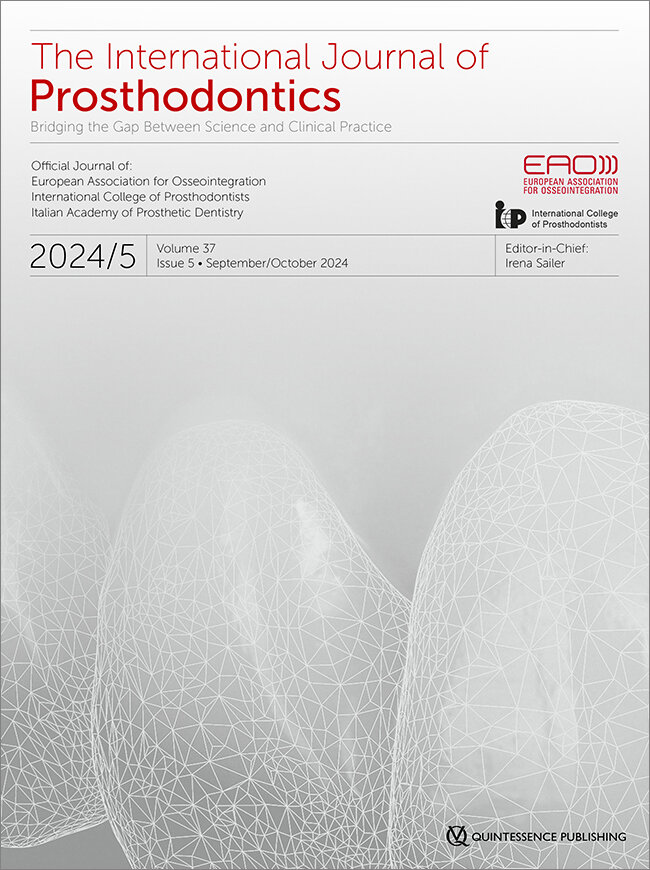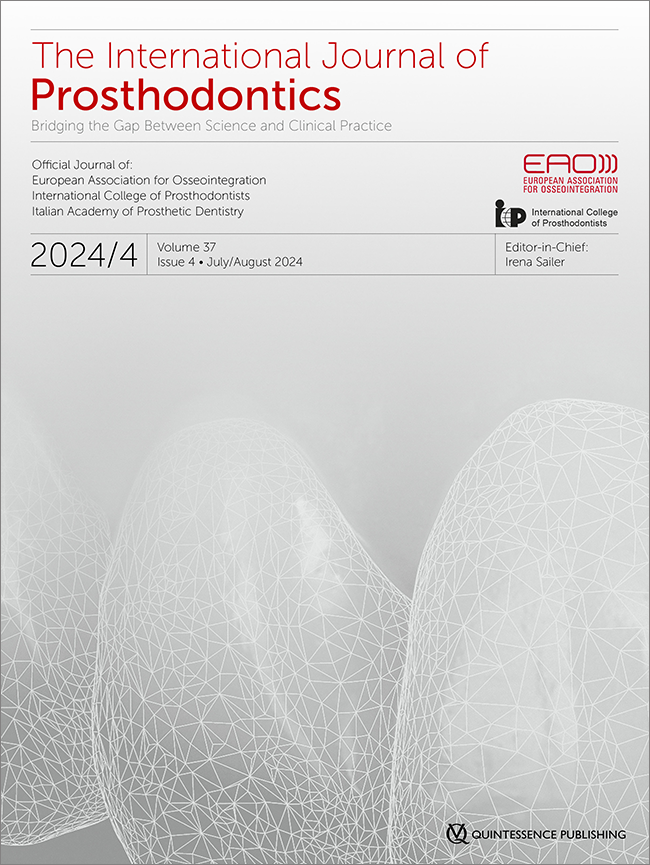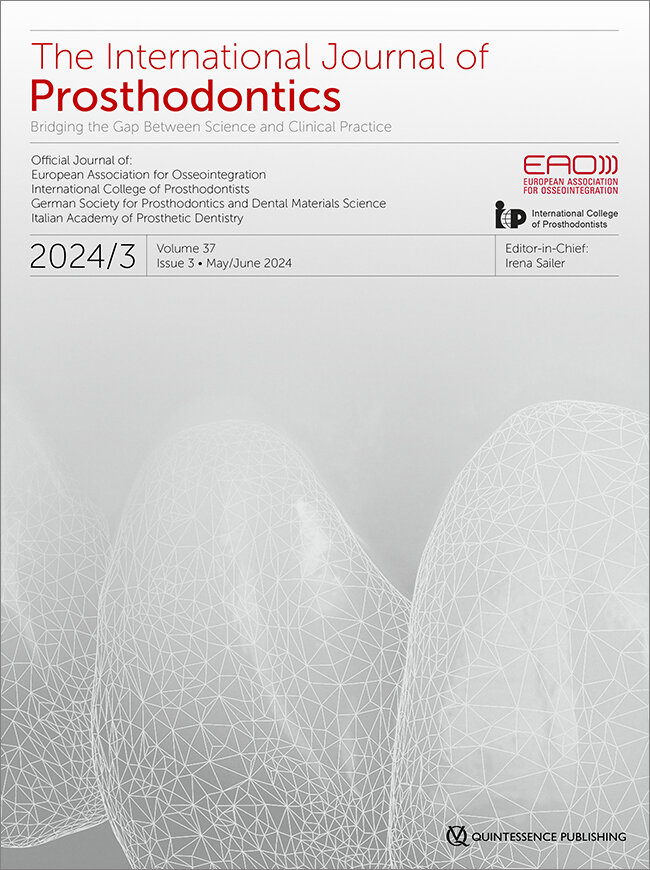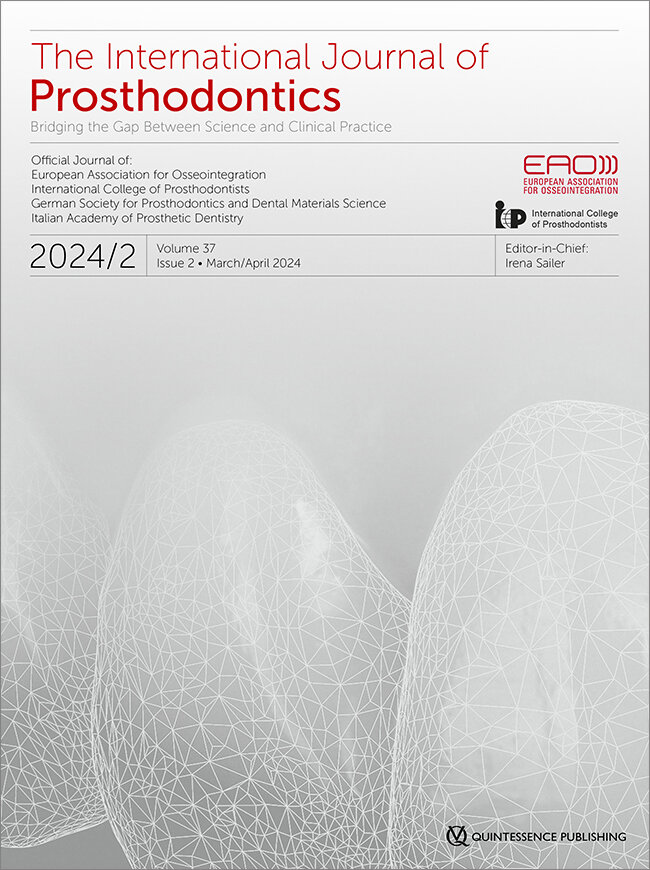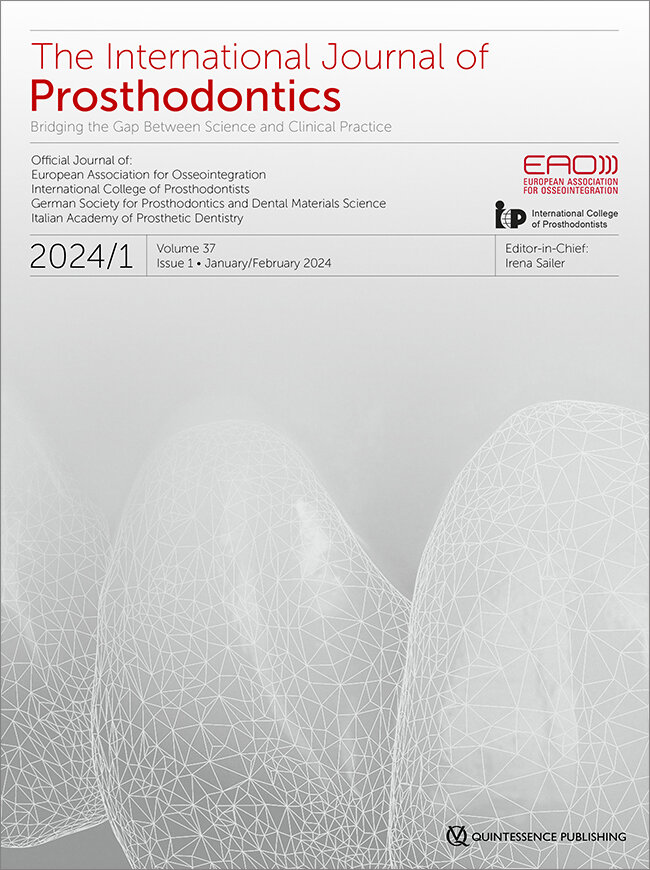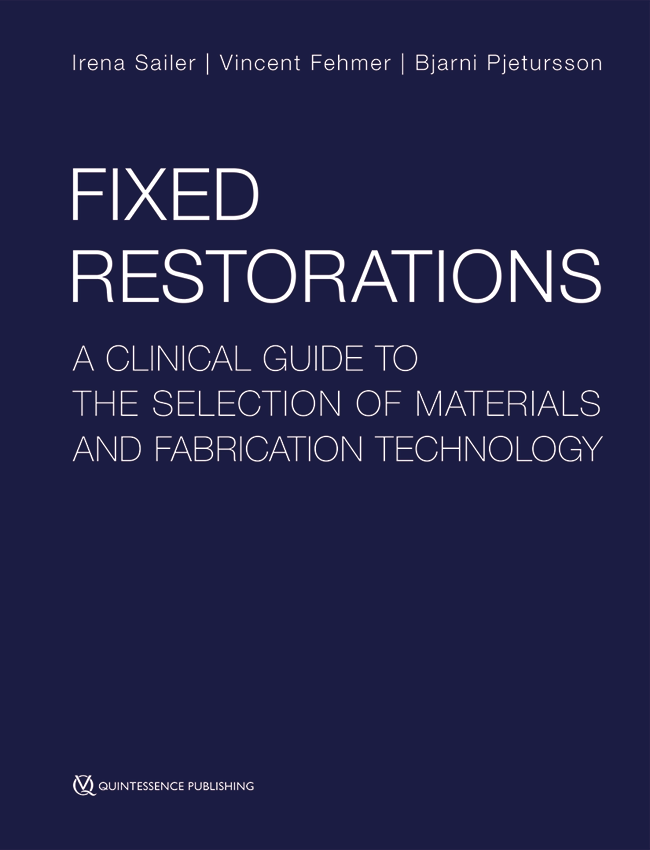Open AccessDOI: 10.11607/ijp.2025.4eSeiten: 381-382, Sprache: EnglischSailer, IrenaEditorial Open AccessDOI: 10.11607/ijp.9128, PubMed-ID: 39486002Seiten: 383-390, Sprache: EnglischSmets, Kathleen / D'haese, Rani / Bultinck, Lisa / Vandeweghe, Stefan / Matthys, CarinePurpose: To evaluate comfort, satisfaction, chewing ability, and complications with digital complete dentures (DCDs) and conventional complete dentures (CCDs). Materials and Methods: For 16 edentulous patients, two sets of maxillary and mandibular dentures were fabricated by students in a university dental clinic. The impression for the DCD was done using indirect scanning of the cast. When the patients were pain free, each set of dentures was worn for 4 weeks. The Oral Health Impact Profile (OHIP-14) and the Denture Satisfaction Index (DSI) were used to measure patient satisfaction and chewing ability, respectively. Both questionnaires were administered before fabrication and after wearing each set. Adjustments made during the follow-up period were included. At the end of the study, patients could express which set of dentures they preferred. The 25 dental students involved in fabricating the dentures were questioned in terms of discomfort, preference, and future use for both techniques. Results: OHIP-14 showed significantly higher scores for DCDs for the domain concerning psychologic discomfort. The DSI showed no significant difference for both sets of dentures. In terms of complications, a significant difference was found for occlusion. DCDs required more occlusal adjustments. A minority of the patients (37.5%) chose DCDs as their favorite set. The students preferred the wax try-in and workflow of the CCDs. Conclusions: CCDs and DCDs showed differences in patient satisfaction. Chewing ability was comparable for both sets of dentures. More occlusal complications were seen in DCDs. Both students and patients preferred the CCDs.
DOI: 10.11607/ijp.9145, PubMed-ID: 39392781Seiten: 391-399, Sprache: EnglischJofré, Jorge / Cartes-Velasquez, Ricardo / Scott, Josephine / Asenjo-Lobos, ClaudiaPurpose: To identify specific personality traits that could potentially undermine the overall satisfaction of the patient with the prosthodontic treatment. Materials and Methods: A literature review was conducted to identify the personality traits (PTs) relevant to patients requiring dental treatment. Later, a Delphi process was employed to classify the selected PTs into their levels of risk to prosthodontic treatment satisfaction, ultimately leading to the development of a personality risk profile (PRP) proposal. The expert panel consisted of specialists with over 10 years of practice experience. The Delphi process involved three rounds of evaluation and consensus building. Results: In total, 26 PTs associated with dental treatment satisfaction were identified. Following the three rounds of the Delphi method, a consensus was achieved, resulting in the classification of these PTs into three PRPs, as follows: low risk (Cooperative, Understanding, Compliant, Trusting, Concerned about their health, Willing, Grateful, and Responsible); moderate risk (Insecure, Overinformed, Demanding, Appearance-obsessed, and Pessimistic); and high risk (Mistrustful, Skeptical, Unwilling, Defiant attitude, Unrealistic expectations, Neglectful, Treatment-resistant, Patient speaks. negatively about other dentists, Violent, Irresponsible, Idealize the dentist, and Controller). Conclusions: This study identified and categorized PTs that have the potential to adversely impact prosthodontic treatment satisfaction. Through this PRP proposal, dental professionals can recognize these patients before initiating prosthodontic interventions.
DOI: 10.11607/ijp.9106, PubMed-ID: 39546280Seiten: 400-403, Sprache: EnglischMuscat, Joseph Christie / Wilkin, Ewa / Rizzo, Daphne / Cortes, Arthur Rodriguez GonzalezThe aim of this article is to present a technique to rehabilitate severely discolored teeth with CAD/CAM zirconia crowns. After confirming the absence of periapical lesions and the presence of sufficient crown structure, any caries or fractured restorations can be removed and replaced with an interim composite restoration. A shoulder subgingival preparation is performed and scanned with an intraoral scanner to design a CAD/CAM zirconia crown using a monolithic zirconia material. This crown is highly polished using a specific polishing kit but not glazed. This technique is suggested to be useful in cases of dark discolored teeth due to staining endodontic materials such as resorcinol-formaldehyde resin.
DOI: 10.11607/ijp.9148, PubMed-ID: 39541517Seiten: 404-408, Sprache: EnglischPrott, Lea S. / von Zitzewitz, Zara A. / Brinks, Ralph / Teeuwen, Robert / Hugger, Alfons / Gierthmühlen, Petra C.This retrospective study evaluated the clinical long-term survival of 1,405 double-crown retained removable partial dentures (DRPDs) over 30 years of follow-up. Kaplan-Meier survival rates for DRPDs were 96.6% after 5 years, 88.2% after 10 years, 61.7% after 20 years, and 38.3% after 30 years. Survival rates of abutment teeth were 94.3% after 5 years, 80.2% after 10 years, 51% after 20 years, and 27% after 30 years. Key failure risk factors of DRPDs were age, ≤ 3 abutment teeth, and complete denture in opposing jaw. Abutment teeth failure risk factors included age, anterior abutment teeth, punctual support, and nonvital teeth.
DOI: 10.11607/ijp.8854, PubMed-ID: 39699969Seiten: 409-417, Sprache: EnglischSadoun, Lionel / Ravalec, Guy / Rohman, Géraldine / Wulfman, ClaudinePurpose: To present a method for predicting the lifetime of dental materials using in vitro thermally accelerated aging. The technique was tested to compare the behavior of three resin base materials for dentures. Materials and Methods: Bar-shaped samples of the polymethyl methacrylate (PMMA)–based resin Probase Hot (Probase), CAD/CAM disk Ivobase CAD (IvoCAD), and high-impact resin IvoCAP were aged in artificial saliva for 15, 30, 45, 60, 90, 120, and 180 days at 55°C, 75°C, and 90°C. Flexural strength and surface roughness of the three resins for each aging duration and temperature were measured for three samples (n = 189). Using the time-temperature equivalence principle and the Arrhenius model, a master curve was constructed, the activation energy of the simulated aging process was calculated, and the lifetime of each material was estimated based on degradation of flexural strength value over time. Results: The mean initial flexural strength was 87.98 ± 7.37, 79.35 ± 10.01, and 97.31 ± 4.97 MPa for IvoCAD, IvoCAP, and Probase, respectively. Activation energies of the aging in artificial saliva were measured at 81.9, 82.6, and 66.2 kJ/mol, respectively, and average lifetimes at 37°C were estimated at 19.5, 14.4, and 9.2 years. Conclusions: In this first approach to estimating the in vitro lifetime in artificial saliva of resin-based materials for dentures, the three materials met the expected criteria, validating the estimation method. Therefore, thermally accelerated aging and the Arrhenius model could be an interesting tool to add to routine tests used to validate new polymer materials and manufacturing processes.
DOI: 10.11607/ijp.9053, PubMed-ID: 38727620Seiten: 418-423, Sprache: EnglischSayeg, João Mateus Cavalaro / Alves Bento, Victor Augusto / Justino de Oliveira Limirio, João Pedro / Del Rei Daltro Rosa, Cleber Davi / Ferreira de Toledo Piza Lopes, Leonardo / Pellizzer, Eduardo PizaPurpose: To evaluate the roughness and color stability of different types of resins used to immerse denture bases in various denture cleansers overnight. Materials and Methods: A total of 150 resin samples were made, which were divided into three groups of denture resins (conventional thermally activated, milled, and 3D printed; n = 50) and subdivided into five subgroups of denture cleaners (Distilled water, Corega tabs, Efferdent, NaOCl 1%, Listerine Cool Hint; n = 10). The roughness properties (Ra) and chromatic difference (ΔE00) were evaluated during 90 days and 180 days of overnight cleaning. Data were evaluated with two way ANOVA and Tukey tests for multiple comparisons (P < .05). Results: Listerine had significantly higher Ra and ΔE values (P < .001) compared to other solutions, which was significant in conventional resin at 180 days (P < .001). Conclusions: The use of Listerine as an overnight cleaner presents greater damage to the optical and surface properties of denture base resins, mainly with conventional resin, and 1% NaOCl is a valid option in relation to cost benefit.
DOI: 10.11607/ijp.9081, PubMed-ID: 40131126Seiten: 424-429, Sprache: EnglischD’haese, Rani / Hermans, Charlotte / Hauspie, Jana / Vandeweghe, StefanPurpose: To evaluate and compare the fit and fracture load of 3D-printed and milled composite onlays. Materials and Methods: An onlay preparation of a mandibular right molar was duplicated 28 times with 3D printing. In total, 14 onlays were milled and 14 onlays were 3D printed. The marginal and internal fit were evaluated using the silicone replica technique. For each impression, two sections were made in the silicone material. Each slice was photographed using a digital microscope, and 13 measurements were performed on both slices using ImageJ. Next, the onlays were cemented on their corresponding models and tested in a universal testing machine to determine the fracture load. Results: The printed onlays showed a significantly better marginal and internal fit (P < .05). The marginal and internal fit for the 3D-printed onlays were, respectively, 78 µm (SD 23 µm) and 222 µm (SD 30 µm), and for the milled onlays the marginal and internal fig were 100 µm (SD 38 µm) and 249 µm (SD 55 µm), respectively. In contrast, the milled onlays showed significantly better results in terms of fracture load (P < .05). Conclusions: Within the limits of this in vitro study, the printing process demonstrated a better fit but with lower mechanical properties. The fit of both the 3D printed and milled composite onlays were within clinically acceptable limits.
DOI: 10.11607/ijp.9119, PubMed-ID: 39110958Seiten: 430-436, Sprache: EnglischAtasoy, Samet / Karademir, Sultan AktuğPurpose: To evaluate the elution of residual monomers from resins used in additively and subtractively manufactured permanent restorations over a period of 1 month, using high performance liquid chromatography (HPLC). Materials and Methods: Two additive manufacturing permanent crown resins (Crowntec [CT] and VarseoSmile Crown Plus [VS]) and a subtractive-manufacturing resin nanoceramic (Cerasmart [CS]) were used to fabricate 30 disc-shaped samples (10 × 2 mm; n = 10). The elution of bisphenol A ethoxylate dimethacrylate (BisEMA), urethane dimethacrylate (UDMA), and triethylene glycol dimethacrylate (TEGDMA) monomers was measured with HPLC at 1 day and 30 days after immersion. One-way ANOVA and post-hoc Tukey tests were used to evaluate differences in eluted monomer concentrations. Paired-sample t tests were used to test the differences in monomer concentration between storage times. Results: CS released BisEMA and UDMA residual monomers, while VS and CT released BisEMA and TEGDMA residual monomers. The residual monomer elution from CT was consistently lower than that from VS for both BisEMA (P < .001) and TEGDMA (P < .001). CS showed a decreasing release pattern in BisEMA (P = .002) and UDMA (P < .001) residual monomers, whereas VS and CT showed an increasing release pattern in BisEMA (P < .001) and TEGDMA (P < .001) residual monomers. Conclusions: The additive-manufacturing composite resins released higher amounts of residual monomers than the subtractive-manufacturing resin nanoceramic. Although the amounts of residual monomers released in the additive manufacturing composite resins increased over time in contrast to the subtractive manufacturing resin nanoceramic, these values were below cytotoxic levels.
DOI: 10.11607/ijp.9022, PubMed-ID: 38758587Seiten: 437-447, Sprache: EnglischFlottes, Yohann / Porcherot, Audrey / Berteretche, Marie-Violaine / Citterio, Hélène / Fromentin, Olivier / Rignon-Bret, Christophe / Braud, Adeline / Wulfman, ClaudinePurpose: To determine whether digital training improves conceptual skills acquisition for custom tray fabrication and tooth arrangement in the preclinical curriculum for complete denture fabrication. Materials and Methods: A crossover design study compared third-year student grades after conventional (manual) and digital training. Half the students were trained with conventional techniques prior to digital, while the other half were trained with digital techniques prior to conventional. The first part of the study (DP1) focused on custom tray fabrication and involved 154 students. The second part (DP2) focused on tooth arrangement with 204 students. The effect of preliminary digital training on conceptual skills was assessed by comparing the results of the students using Student t test. Results were also analyzed by ranking the students’ Perceptual Ability Test (PAT) score. Finally, students’ satisfaction with the training was investigated. Results: Students who completed the initial digital session achieved better custom tray fabrication and tooth arrangement in the subsequent manual sessions. For manual laboratory work, the most dexterous students (PAT1 group) demonstrated the best performance. However, PAT2 students had the best performance during the digital sessions during DP1, and PAT1 and PAT2 students had the best performance during the digital sessions during DP2. Additionally, 40% of DP1 and 12% of DP2 students expressed satisfaction with digital sessions. Conclusions: With complementary manual and digital teaching, digital tools may be useful for enhanced student learning. Digital training has contributed to improved results in manual sessions but did not affect student satisfaction and remained a limited tool to detect learning difficulties.
Schlagwörter: complete denture curriculum; digital dentistry; digital learning; preclinical simulation; custom tray; tooth arrangement; pedagogical study
DOI: 10.11607/ijp.9052, PubMed-ID: 39913856Seiten: 448-456, Sprache: EnglischKavrama, Fatma Uslu / Aydin, Nazli / Yosuncigir, Halit / Ucar, YurdanurPurpose: To evaluate the effect of build angle on the flexural strength (FS), elastic modulus (E), and hardness (VH) of stereolithography (SLA)–based 3D-printed custom tray resin. Materials and Methods: 3D-printed specimens with dimensions of 65.0 × 10.0 × 3.3 mm ± 0.2 mm were manufactured with different build angles (90, 120, 135, 150, 180 degrees) using custom tray resin. For preparing the specimens in the control groups, the autopolymerizing (AP) resin and the ultraviolet polymerizing (UV) resin were used. FS and E were determined by a three-point bending test, and hardness was evaluated with the VH test. Fracture surfaces were evaluated with scanning electron microscopy (SEM). Statistical analysis of the data was made using one way ANOVA followed by Dunnett T3 test. Results: Considering all parameters, the UV group was statistically significantly lower than the other groups. The mean E value of the 90D group was statistically significantly different than those of the 150D group (P = .000) and the 180D group (P = .002). The mean E value of the 120D group was statistically significantly different than those of the 150D group (P = .003) and the 180D group (P = .013). The AP group showed a higher mean VH number (20.20 ± 2.08), and the difference was statistically significant compared to the 3D-printed groups (P < .005). Conclusions: Considering its mechanical properties, it was appropriate to arrange the build angles at different degrees when manufacturing reliable custom trays using SLA. The 3D-printed custom tray production method was a more standard method compared to AP and UV.
DOI: 10.11607/ijp.9115, PubMed-ID: 40172942Seiten: 457-482hh, Sprache: EnglischRazaghi, Nahal / Gill, Thomas / Patankar, Anuya / Petrie, Aviva / Shahdad, ShakeelPurpose: To determine the significance of primary stability, as measured by insertion torque (IT) and/or implant stability quotient (ISQ), in achieving osseointegration of nonimmediately loaded implants. Materials and Methods: Three electronic databases were searched. Studies were included if they measured IT and/ or ISQ at time of placement and reported survival for up to 1 year. For studies where at least one implant failed, a random effects meta-analysis was carried out for the odds of survival. Results: In total, 3,431 publications were screened, and 79 were accepted for analysis. These included 28 RCTs, 12 CCTs, 10 cohort studies, and 29 case series. Overall, 21 studies provided individual implant data for a total of 1,413 implants, and 7 studies were included for meta-analysis. A total of 264 implants were placed with ISQ < 60 and 249 with IT < 35. Survival of implants placed with ISQ < 60 and IT < 35 were 97.7% and 95.2%, respectively. Meta-analysis found no evidence that an ISQ ≥ 60 was less likely to fail compared to ISQ < 60 (OR 0.54, 95% CI 0.17 to 1.75, P = .31), or that an IT ≥ 35 resulted in higher odds of failure compared to IT < 35 (OR 0.82, 95% CI 0.13 to 5.40, P = .84). Conclusions: This study found no evidence to support that an IT ≥ 35 or ISQ ≥ 60 for nonimmediately loaded implants results in higher survival than those below these values.
DOI: 10.11607/ijp.9207, PubMed-ID: 40172943Seiten: 483-490, Sprache: EnglischHe, Zihan / Li, Ruyi / Zhang, Xin / Wan, Qianbing / Zhu, Zhou / Wang, JianReport of a clinical case about occlusal rehabilitation under a digital workflow for partial edentulism using multifunctional Gothic arch tracing devices. The individualized Gothic arch tracing devices were designed based on the virtual patient model, enabling the recording of the centric relation, previewing the esthetics of maxillary teeth, and aiding in assessment of the temporomandibular joint function. Serving as a preimplant treatment, the removable partial dentures were delivered to the patient within two follow-up visits, establishing a stable occlusal relationship. Based on the previously recorded centric relation, the final implant-supported fixed prostheses were applied. The patient expressed satisfaction with the restoration in terms of esthetics and functionality.




